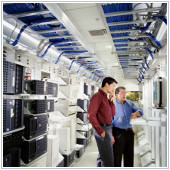| Save energy and expense in your data center |
Perform an energy auditThere’s a good chance your IT staff has never once thought about how much energy your server room and data center are consuming. So, the first step to rectifying this problem is to identify just how much power is being sucked up. To get you started, here are a few questions to ask:
Answering these questions will help you determine just how efficient, or inefficient, your data center actually is. Decrease the IT workloadWhen you save a single watt of energy at the server level, it can result in a total saving of nearly three watts in your data center costs. So how do you decrease the IT workload? Virtualization is a common and effective tactic. Instead of wasting money on cooling your own servers in your data center, with virtualization you can have them hosted by your IT provider and then their technology delivered to you through the Internet. This allows you to eliminate some of your servers from your office and therefore reduce cooling costs. For alternate ways to decrease server workload, you can also:
Mind your humidity and temperature levelsBecause many non-IT personnel are terrified of the data center and simply don’t understand it, often they falsely believe that the room must be kept as cold as the North Pole in order to protect sensitive data. This is simply not true. While it is true that excessively high temperatures, humidity or dry conditions can harm your data, most modern-day data center equipment is incredibly durable and can tolerate a much wider range of humidity and temperatures than in decades past. Because of this, it is highly likely you can get away with a lot less cooling and dehumidification than you thought possible. That said, it’s wise to consult with an IT professional before doing this to ensure you don’t damage your data. Another innovation that can help you cool down your data center more economically is utilizing an economizer system. This technology uses cool air from the outside to provide “free” cooling cycles for your data center. Want more tips on reducing your overall IT bill? Curious to learn more about virtualization? Call us today to learn from one of our experts. Published with permission from TechAdvisory.org. Source.
|
| Take Office anywhere on Windows 10 |
|
| How to start your company’s ORM |
|
| BCP implementation challenges |
|

 For many business owners, the server room is one of those places you’d like to ignore, pray there’s never a problem with, and otherwise pretend doesn’t exist. It’s a foreign world, and it may even be a bit scary to you. But your feelings towards it don’t change the fact that it has the potential to skyrocket your electricity bills. Here are a few ideas to get your server room and data center energy expenses under control.
For many business owners, the server room is one of those places you’d like to ignore, pray there’s never a problem with, and otherwise pretend doesn’t exist. It’s a foreign world, and it may even be a bit scary to you. But your feelings towards it don’t change the fact that it has the potential to skyrocket your electricity bills. Here are a few ideas to get your server room and data center energy expenses under control. You can edit that Word document from the runway, input data to an Excel file from the ballpark or create a PowerPoint presentation without the need to open up your laptop with the new Office Mobile apps from Microsoft. The apps, available to users of Windows 10 at no extra cost, are designed for tablets with a “touch-first” interface. The increased functionality makes creating or editing Office documents on your tablet a breeze.
You can edit that Word document from the runway, input data to an Excel file from the ballpark or create a PowerPoint presentation without the need to open up your laptop with the new Office Mobile apps from Microsoft. The apps, available to users of Windows 10 at no extra cost, are designed for tablets with a “touch-first” interface. The increased functionality makes creating or editing Office documents on your tablet a breeze. Almost every company out there has a website and social media presence, but the most successful ones also use Online Reputation Management (ORM). Simply having an online presence is no longer enough; your company must also be constantly monitoring it. It’s easy to start working on your ORM and use it to take your company to the next level.
Almost every company out there has a website and social media presence, but the most successful ones also use Online Reputation Management (ORM). Simply having an online presence is no longer enough; your company must also be constantly monitoring it. It’s easy to start working on your ORM and use it to take your company to the next level. Business continuity planning (BCP) is critical to all companies regardless of size. If disaster were to strike, an effective BCP would protect your valuable data and prevent your company from falling on its knees. Yet the implementation of a BCP presents challenges in itself. You need to address the following issues to ensure that your organization is on the right track to build and maintain a successful business continuity plan.
Business continuity planning (BCP) is critical to all companies regardless of size. If disaster were to strike, an effective BCP would protect your valuable data and prevent your company from falling on its knees. Yet the implementation of a BCP presents challenges in itself. You need to address the following issues to ensure that your organization is on the right track to build and maintain a successful business continuity plan.